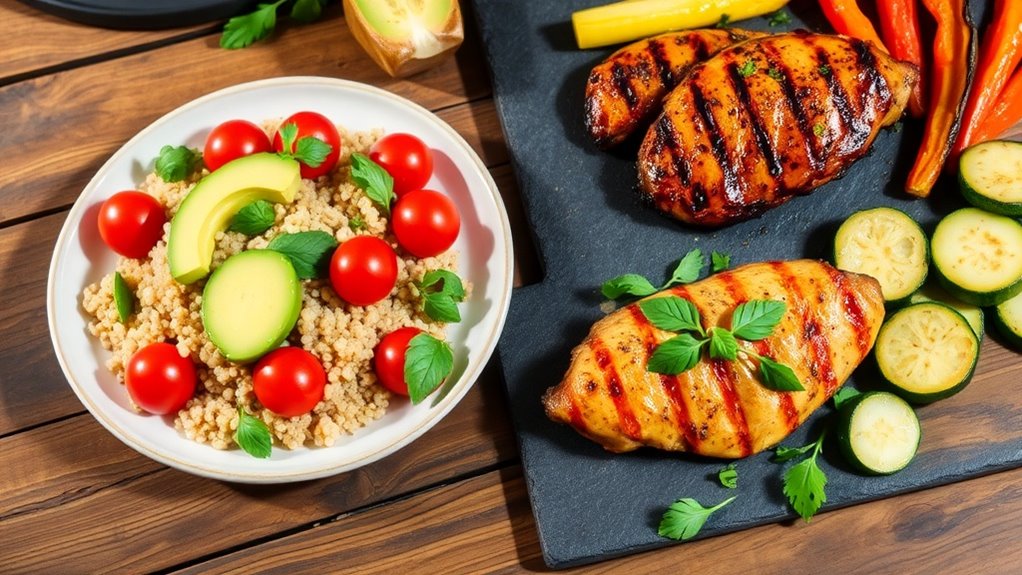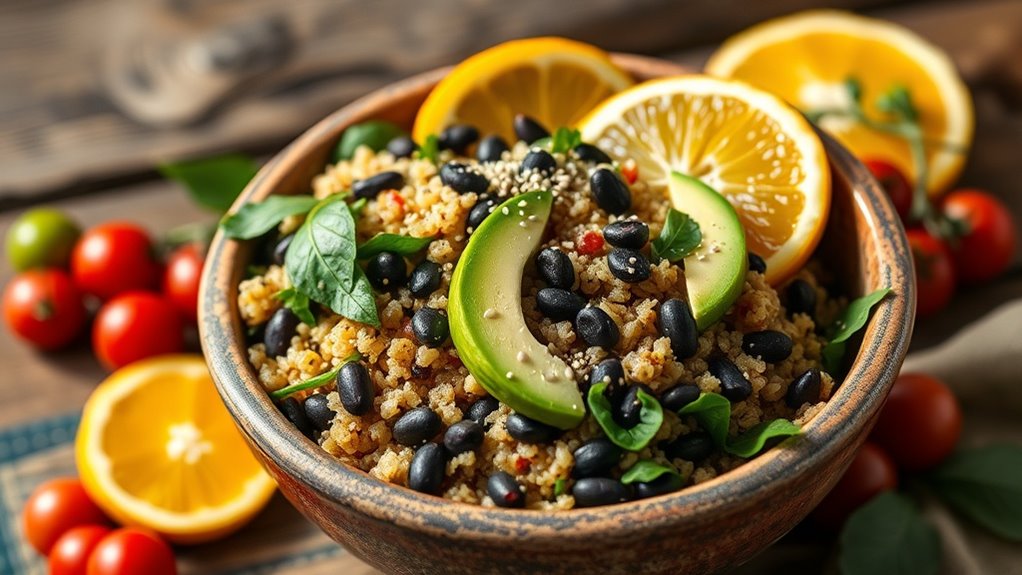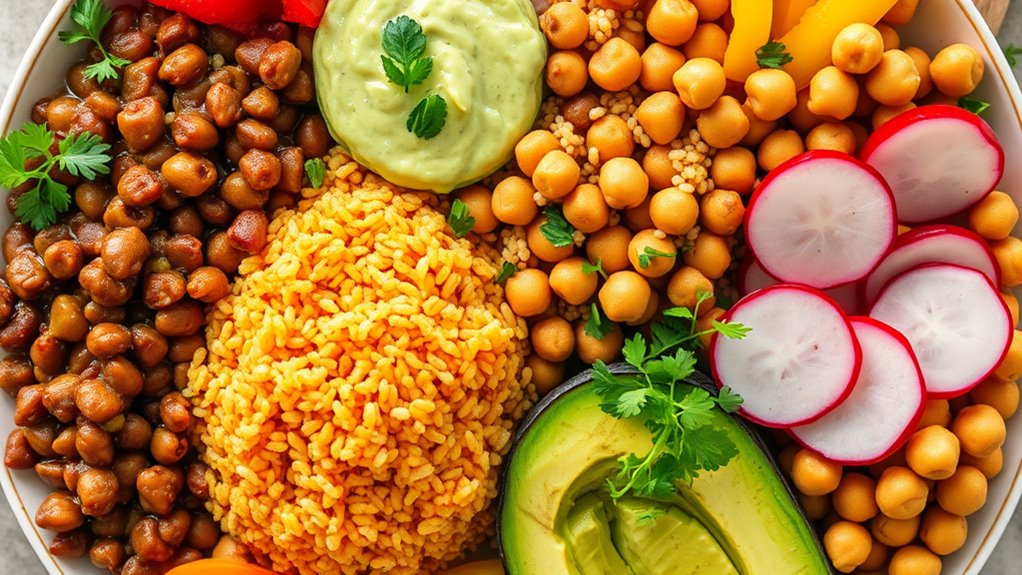Unexpected Plant-Based Protein Sources You Must Try!
If you’re looking to boost your protein intake, dive into some unexpected plant-based sources like teff, spirulina, and nutritional yeast. Teff packs a high-protein punch and is versatile in many dishes worldwide, while spirulina offers a complete amino acid profile. Nutritional yeast isn’t just for flavor; it’s rich in B vitamins and protein. Explore these options to enrich your meals and discover even more about their incredible benefits and culinary uses.
Key Takeaways
- Spirulina is a robust alternative protein, boasting 60-70% protein content.
- Nutritional yeast, a cheesy flavor enhancer, packs all essential amino acids.
- Hemp seeds offer a complete protein source plus a balance of essential fatty acids.
- Chia seeds add protein along with omega-3s to support heart and digestive health.
- Teff, a tiny grain, excels in protein, fiber, and essential minerals, versatile in global cuisines.
Exploring the Protein Power of Spirulina
Why not consider spirulina as a powerhouse of protein in your diet? This blue-green algae isn’t just an algae; it’s one of the most unexpected proteins you’ll encounter.
In your quest to master alternative nutrition sources, spirulina stands out with a protein content that rivals traditional animal sources, boasting about 60-70% protein by dry weight.
It’s a complete protein, containing all essential amino acids, crucial for muscle repair, immune function, and more. In addition to its impressive protein quantities, spirulina is also lauded for its environmental impact, showing lower greenhouse gas emissions and less water usage compared to conventional livestock farming.
The Surprising Benefits of Hemp Seeds
After exploring the robust protein profile of spirulina, let’s turn our attention to another remarkable plant-based protein: hemp seeds.
You might know them as the small, nutty-flavored seeds derived from the Cannabis sativa plant, but they’re packed with more than just flavor. Did you know that hemp seeds are a complete protein source? This means they contain all nine essential amino acids that your body can’t produce on its own.
They boast an impressive 9.46 grams of protein per 30 grams (about three tablespoons), rivaling that of soybeans. Furthermore, hemp seeds are rich in essential fatty acids like omega-3 and omega-6 in a ratio optimal for human health.
Diving into hemp seeds as a protein source can enhance your diet substantially, offering unique benefits that support muscle repair and overall wellness.
Additionally, incorporating hemp seeds into recipes is incredibly easy, whether blended into smoothies or sprinkled on salads, making them a versatile addition to your culinary repertoire.
Chia Seeds: Tiny but Mighty Protein Packs
Shifting our focus to another excellent plant-based protein, consider chia seeds, often underestimated in their power. Don’t let their size fool you. These tiny seeds pack a significant protein punch, with about 6 grams per two-tablespoon serving. They’re also rich in calcium, magnesium, and omega-3 fatty acids, making them a well-rounded addition to your diet. Incorporating chia seeds into meals is also an effective way to enhance satiety, helping with weight management and reducing snacking tendencies.
| Nutrient | Benefit |
|---|---|
| Protein | Supports muscle repair and growth |
| Omega-3 Fatty Acids | Enhances brain health and reduces inflammation |
| Fiber | Aids digestive health and maintains satiety |
Harnessing the Protein Richness of Quinoa
Quinoa, often hailed as a superfood, offers an impressive 8 grams of protein per cooked cup. This complete protein source contains all nine essential amino acids that your body can’t synthesize on its own, making it exceptionally valuable in a plant-based diet. You’ll find quinoa’s versatility second to none; it can be seamlessly integrated into salads, turned into a hearty porridge, or used as a base for burgers, enhancing both the texture and protein content of your meals. Consider using quinoa as a substitute for rice or pasta; not only does it boost your protein intake, but it also helps increase your fiber and mineral consumption. Truly, mastering the use of quinoa can elevate your nutrition significantly.
Quinoa’s impact goes beyond just nutrition, as it’s also environmentally sustainable compared to many other protein sources, aligning well with eco-friendly eating habits.
Nutritional Yeast: A Flavorful Protein Boost
As you explore the world of plant-based proteins, consider adding nutritional yeast to your pantry for its flavorful and nutritious boost. Often dubbed “nooch”, this deactivated yeast is a powerhouse of nutrition, boasting significant protein content and a range of B vitamins essential for energy and brain function.
Here’s a quick glance at some key benefits and uses of nutritional yeast:
| Benefit | Description |
|---|---|
| Protein Content | High in complete protein, containing all 9 essential amino acids. |
| Flavor Profile | Offers a cheesy, umami-rich flavor suitable for various dishes. |
| Vitamins | Rich source of B-complex vitamins, including B12, crucial for vegetarians. |
Incorporate it into sauces, sprinkle over popcorn, or blend into smoothies for that extra nutritional punch. Additionally, nutritional yeast can help elevate plant-based meals in both nutrition and taste, aligning well with the increasing demand for diverse vegan protein sources.
Discover the Wonders of Green Peas as a Protein Source
While nutritional yeast is a standout choice, don’t overlook green peas as a superb source of protein. Rich in essential amino acids, these vibrant spheres offer about 8 grams of protein per cup, making them a strong ally in your plant-based diet arsenal.
You’ll find that incorporating green peas into your meals not only enhances your protein intake but also contributes critical fiber and antioxidants that optimize overall health.
Master the art of using green peas by integrating them into a variety of dishes. From blending into a smooth, hearty pea soup to tossing them fresh into salads, their versatility is unmatched.
Elevate your culinary creations further by combining them with other proteins like quinoa to create well-rounded, nutritious meals.
The Protein Potential of Wild Rice
If you’ve explored the benefits of green peas, you’ll be intrigued by the nutritional offerings of wild rice.
This unique grain, often overshadowed by its commonplace cousins, packs a powerful protein punch that’s perfect for enhancing your plant-based diet. Distinguished from typical rice varieties, wild rice boasts a higher protein content, providing about 6 to 8 grams per cooked cup.
Its remarkable profile doesn’t stop there; wild rice is rich in fiber, antioxidants, and essential amino acids, making it a robust, holistic choice for your nutritional needs.
Integrating wild rice into your meals not only diversifies your dietary palette but also bolsters your intake of plant-based proteins, vital for muscle repair and general health maintenance.
Amaranth: an Ancient Grain With Modern Protein Benefits
Shifting focus to amaranth, this ancient grain has been revered for centuries yet remains remarkably relevant in today’s health-conscious diets.
As you explore plant-based proteins, you’ll find amaranth’s profile uniquely compelling. It’s not only rich in protein but also boasts a complete set of amino acids, including lysine, which is often limited in plant foods. This makes amaranth an excellent choice for sustaining your muscle health.
Furthermore, its high fiber content aids in digestion and long-lasting satiety, critical for weight management. Incorporate amaranth into your meals by using it in place of rice or quinoa. Cook it up in savory dishes or sweeten your mornings with amaranth-based porridge, enhancing your diet with its versatile, nutritional offerings.
Teff: Unlocking the Protein Secrets of an Ethiopian Staple
As you explore teff, you’ll find that this tiny grain packs a substantial nutritional punch, integral to Ethiopian cuisine and gaining popularity worldwide.
You might’ve noticed it in recipes ranging from bread to beverages.
Now, let’s examine teff’s remarkable protein profile and its versatility in kitchens across the globe.
Teff’s Nutritional Profile
While teff may not yet be a household name globally, this tiny grain boasts a robust nutritional profile.
You’ll find that it’s exceptionally high in protein, with about 13 grams per 100 grams, supporting muscle repair and growth. It’s also a rich source of dietary fiber, enhancing your digestion and helping maintain blood sugar levels.
Furthermore, teff provides a suite of essential minerals, notably calcium, iron, and magnesium, pivotal for bone health, oxygen transport, and enzyme function.
Vitamins, especially those from the B complex, abound in teff, aiding in energy metabolism and red blood cell production.
It’s gluten-free as well, making it a vital diet component for those with celiac disease or gluten sensitivity.
Culinary Uses Worldwide
Although teff is a staple in Ethiopia, its culinary applications extend far beyond its origins. You’ll find this versatile grain making culinary waves internationally. Its mild, nutty flavor and high protein content make it a sought-after ingredient for innovative chefs and home cooks alike who are keen to explore its potential.
Here’s a quick showcase of teff’s versatility in global cuisine:
| Country | Dish | Description |
|---|---|---|
| USA | Teff Porridge | Creamy breakfast staple. |
| Italy | Teff Polenta | A gluten-free twist on a classic. |
| India | Teff Roti | Nutritious flatbread. |
| Australia | Teff Pancakes | Light, fluffy, and protein-rich. |
Consider incorporating teff into your diet to experiment with its unique textures and flavors while boosting your protein intake.
Frequently Asked Questions
How Do Plant-Based Proteins Compare to Animal-Based in Digestion?
As in the fable of tortoise and hare, you’ll find plant-based proteins digest slower than animal proteins, reducing strain on your system and enhancing nutrient absorption, leading to a steadier energy release.
Can These Protein Sources Trigger Allergies?
Yes, you may find some plant-based proteins can trigger allergies, especially if you’re sensitive to components like soy or gluten. It’s essential to identify your allergens when incorporating new proteins into your diet.
Are These Proteins Complete With All Essential Amino Acids?
Like keys unlocking health, you’ll find many plant proteins aren’t complete. You’ll need to combine different foods, like rice and beans, to ensure you’re getting all essential amino acids in your diet.
What Is the Cost Comparison to Traditional Protein Sources?
You’ll often find plant-based proteins are less expensive than traditional animal sources, due to lower farming and production costs. This price difference might vary based on your location and the specific products you choose.
How Sustainable Are These Plant-Based Protein Sources?
You might wonder how these options stack up sustainability-wise. Most offer significant advantages, using less water and land while emitting fewer greenhouse gases compared to conventional meats. They’re a future-forward choice, truly.





